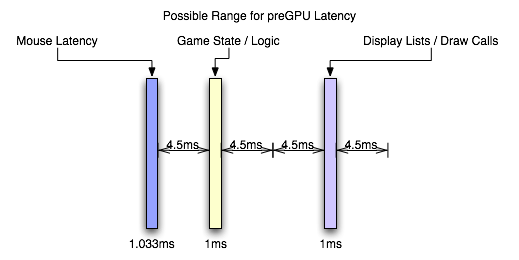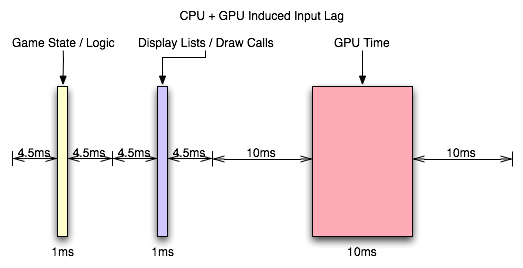Of the GPU and Shading
This is my favorite part, really. After the CPU has started sending draw calls to the graphics card, the GPU can begin work on actually rendering the frame containing the input that was generated somewhere in the vicinity of 3ms to 21ms ago depending on the software (and it would be an additional 1ms to 7ms for a slower mouse). Modern, complex, games will tend push up to the long end of that spectrum, while older games (or games that aren't designed to do a lot of realistic simulation like twitch shooters) will have a lower latency.

Again, the actual latency during this stage depends greatly on the complexity of the scene and the techniques used in the game.
These days, geometry processing and vertex shading tend to be pretty fast (geometry shading is slower but less frequently used). With features like instancing and the fact that the majority of detail is introduced via the pixel shader (which is really a fragment shader, but we'll dispense with the nit picking for now). If the use of tessellation catches on after the introduction of DX11, we could see even less actual time spent on geometry as the current level of detail could be achieved with fewer triangles (or we could improve quality with the same load). This step could still take a millisecond or two with modern techniques.
When it comes to actual fragment generation from the geometry data (called rasterization), the fixed function hardware and early z / z culling techniques used make this step pretty fast (yet this can be the limiting factor in how much geometry a GPU can realistically handle per frame).
Most of our time will likely be spent processing pixel shader programs. This is the step where every pin point spot on every triangle that falls behind the area of a screen space pixel (these pin point spots are called fragments) is processed and its color determined. During this step, texture maps are filtered and applied, work is done on those textures based on things like the fragments location, the angle of the underlying triangle to the screen, and constants set for the fragment. Lighting is also part of the pixel shading process.
Lighting tends to be one of the heaviest loads in a heavily loaded portion of the pipeline. Realistic lighting can be very GPU intensive. Getting into the specifics is beyond the scope of this article, but this lighting alone can take a good handful of milliseconds for an entire frame. The rest of the pixel shading process will likely also take multiple milliseconds.
After it's all said and done, with the pixel shader as the bottleneck in modern games, we're looking at something like 6ms to 25ms. In fact, the latency of the pixel shaders can hide a lot of the processing time of other parts of the GPU. For instance, pixel shaders can start executing before all the geometry is processed (pixel shaders are kicked off as fragments start coming out of the rasterizer). The color/z hardware (render outputs, render backends or ROPs depending on what you want to call them) can start processing final pixels in the framebuffer while the pixel shader hardware is still working on the majority of the scene. The only real latency that is added by the geometry/vertex processing portion of the pipeline is the latency that happens before the first pixels begin processing (which isn't huge). The only real latency added by the ROPs is the processing time for the last batch of pixels coming out of the pixel shaders (which is usually not huge unless really complicated blending and stencil technique are used).
With the pixel shader as the bottleneck, we can expect that the entire GPU pipeline will add somewhere between 10ms and 30ms. This is if we consider that most modern games, at the resolutions people run them, produce something between 33 FPS and 100 FPS.
But wait, you might say, how can our framerate be 33 to 100 FPS if our graphics card latency is between 10ms and 30ms: don't the input and CPU time latencies add to the GPU time to lower framerate?

The answer is no. When we are talking about the total input lag, then yes we do have to add these latencies together to find out how long it has been since our input was gathered. After the GPU, we are up to something between 13ms and 58ms of input lag. But the cool thing is that human response happens in parallel to input gathering which happens in parallel to CPU time spent processing game logic and draw calls (which can happen in parallel to each other on multicore CPUs) which happens in parallel to the GPU rendering frames. There is a sequential path from input to the screen, but we can almost look at this like a heavily pipelined path where each stage operates in parallel on a different upcoming frame.
So we have the GPU rendering the previous frame while simulation and game logic are executing and input is being gathered for the next frame. In this way, the CPU can be ready to send more draw calls to the GPU as soon as the GPU is ready (provided only that we are not CPU limited).
So what happens after the frame is finished? The easy answer is a buffer swap and scanout. The subtle answer is mounds of potential input lag.










85 Comments
View All Comments
snarfbot - Friday, July 17, 2009 - link
i have a crt and a plasma tv, both essentially lag free.my friends have tn monitors, also no perceivable lag.
the worst offender is my friends samsung tv, its noticeably laggy.
but no where near as bad as wireless mice. they gotta be in the 30+ms region.
nevbie - Friday, July 17, 2009 - link
My mouse wire is about the same length as my monitor cable. It's too bad the latter doesn't have same relative bandwidth.1. But 16ms? Is it still around 16ms if the resolution is halved, which would cut the amount of data per frame to 1/4, or is the 16ms some kind of worst case?
2. Does the "input lag"(I'd prefer calling it response time) change if you use VGA (analog) connection instead of DVI (digital)? That would be a funny workaround.
DerekWilson - Friday, July 17, 2009 - link
1) scanout is always around 16ms regardless of resolution. blanking is always around 0.5ms regardless of resolution as long as the refresh rate is set to 60Hz. it's the VESA standards that determine this. Higher refresh rates mean faster transmission times. cable bandwidth limits maximum resolution+refresh. LCD makers are really the ones to blame for higher refresh rates not being available with lower resolutions ... I believe the traditional limit to this was LCD response time.2) i don't believe so.
bob4432 - Friday, July 17, 2009 - link
so how slow is my ps/2 trackman wheel connecting into a 4 port kvm? never thought about this area of gaming...interesting.DerekWilson - Friday, July 17, 2009 - link
I'm not sure if the kvm adds significant delay or not ... that'd be an interesting question.I do believe that ps/2 is 100Hz (10ms) though ... so ... ya know, slower :-)
anantec - Thursday, July 16, 2009 - link
i would love to see some analysis of wireless input devices, and keyboards.anantec - Thursday, July 16, 2009 - link
for example, the wireless controler for playstation 3and recently razer made a wireless gaming mouse
http://www.razerzone.com/gaming-mice/razer-mamba/">http://www.razerzone.com/gaming-mice/razer-mamba/
as the article mentioned, usb device is limited to 1000Hz, what about bluetooth devices?
Stas - Thursday, July 16, 2009 - link
Really appreciate the article. Even though I didn't learn much from it. It is VERY useful to point people to when the topic comes up. "Huh, Input lag? What's that? I'm on broadband, dude, and I have a QUAD-CORE!!!" <--- With ppl like that, I, now, have more than 2 options (murder them, or spend 30 min explaining input lag), I can send them to AnAndTech. You guys, own.marraco - Thursday, July 16, 2009 - link
Thanks for such useful article.The tweaking on the mouse was one I never had seen before (and I search for tweaks regularly).
One thing that I would add, is that some games (as FEAR 2) include controls for mouse smoothing, and/or some way to increase mouse responsivenes. They really affect my imput lag perception.
jkostans - Thursday, July 16, 2009 - link
I use a G5 mouse, and a CRT running at 100Hz. As long as my computer pushes 100+fps I don't notice any input lag at all.This is what I've found to contribute to input lag in order of significance:
Framerate, refresh rate, mouse rate. Oh and I've never used an LCD I can't stand the ghosting.